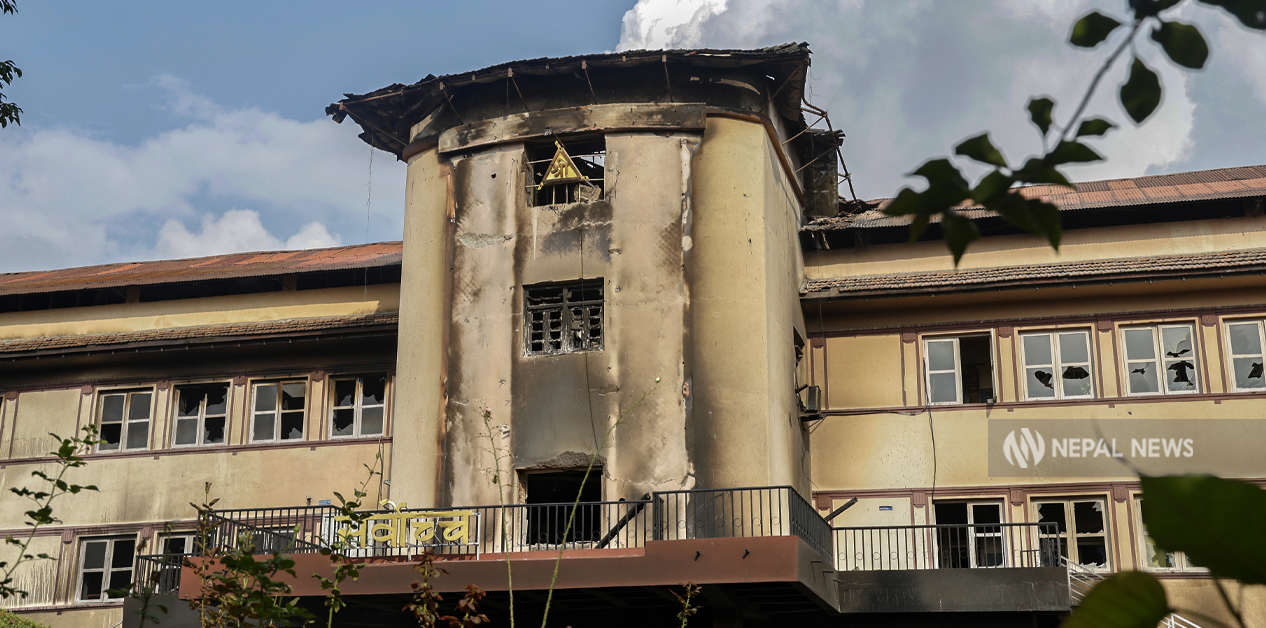

KATHMANDU: The full bench meeting of the Supreme Court held on October 26 decided to file a police report regarding the incidents of arson and vandalism at the courts during the Gen Z movement.
According to Supreme Court Deputy Registrar Nirajan Pandey, the concerned courts where arson and vandalism occurred will now register applications at the nearest police office.
“The police were already told to investigate,” he said, “Now the court will go to the police office with the complaint, including the inventory.”
This move by the Supreme Court, where the court itself—the final body to settle all cases—becomes the complainant, has created a stir in the justice sector.
Legal experts believe that this raise concerns that the court itself might be going against the principle of impartiality.
“The court itself carrying the complaint raises questions about the principle of ‘Fair Trial’,” says Senior Advocate Tikaram Bhattarai, “Questions will arise over the court’s impartiality and independence, and from the perspective of natural justice, the court should not be the petitioner.”
The court itself can even initiate a contempt of court case based on a report. Following the full bench decision, as the matter involves vandalism and arson, court employees themselves may go as petitioners.
Stating that the vandalism and arson in the court are unforgivable, heinous crimes and that the culprits must be given the maximum punishment, Senior Advocate Bhattarai says that for this, the court should provide the details of the damage to the police, and it would be appropriate for the police themselves to act as the complainant to conduct the investigation and prosecution. “The court losing its self-restraint in any adverse situation is not considered good,” he says.
Former General Secretary of the Nepal Bar Association, Leelamani Paudel, also states that the practice of the institution that delivers justice itself becoming the complainant weakens the principle of impartiality.
“There is no practice of the court itself becoming the complainant and moving the case forward. This is like looking at the case oneself and being the judge oneself,” he says.
Paudel says that such a decision coming from the Supreme Court’s full bench allows for questioning the working capacity of the judges themselves.
He says, “If, in the occasional sitting of judges, it is suggested that a complaint be filed, it can be considered normal. If it is a decision, then the judges’ conscience did not do the right thing.”
However, Senior Advocate Madhav Kumar Basnet says that since principles cannot override law, the Supreme Court’s decision will not have a major impact. “It is probably meant to say, ‘Investigate and take action,’ not to directly file a petition and go. The biggest exception to principle is the law,” he says, “I don’t think this affects the principle of natural justice.”
The court itself can even initiate a contempt of court case based on a report. Following the full bench decision, as the matter involves vandalism and arson, court employees themselves may go as petitioners.
“Since it is unprecedented for the decision-maker itself to carry the petition, it is natural to find it unusual,” says former President of the Nepal Bar Association, Gopal Krishna Ghimire, “We can comment after looking at how the petition is filed and its nature.”
Supreme Court Deputy Registrar Pandey says that since it is a full bench decision, the administration will not comment on it. He says, “The administration does not question the full bench decision; it is directly implemented.”
23 courts burned across the country
According to Deputy Registrar Pandey, 23 courts across the country, including the Supreme Court, were set on fire during the Gen Z movement.
Out of these, 10, including the Supreme Court and Kathmandu District Court, suffered complete damage, 9 suffered partial damage, and 4 courts sustained minor damage.
Along with the Supreme Court building, 422 vehicles and 933,823 case files were burnt in the arson. Pandey states that 706,071 case files were burnt and destroyed in other courts.
During the movement, the buildings of the High Court Tulsipur, High Court Butwal, and the Hetauda bench of the High Court Patan were also destroyed.
The buildings of the District Courts of Kathmandu, Morang, Chitwan, Kaski, Tanahun, and Banke are also in unusable condition.
Deputy Registrar Pandey says that the Supreme Court has instructed all courts where arson and vandalism occurred to file a police report.